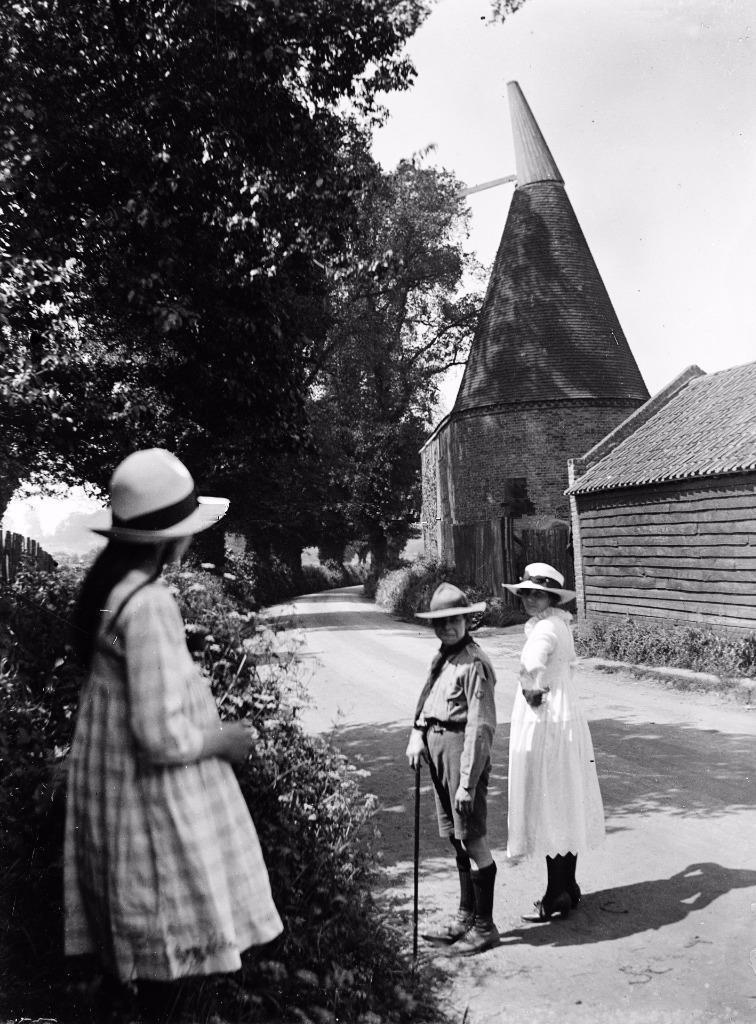
English Regions: Home Counties--Kent

Figure 1.--This glass-plate negative print shows a scene from Crockenhill village in Kent. We see a Boy Scout with two girls. The Scout helps to date the image. We believe it was taken in the 1910s. Crockenhill was a small village in the Sevenoaks District of Kent near Swanley. It is now located near the border of Kent and Greater London. At the time this photograph was taken the city had not yet expanded even near the village.
|
|
Kent is the southeast corner of England and one of the Home Counties--,eaning the counties surrounding Lonson. Greater London is located to the northwest, Surrey to the west, East Sussex to the southwest, and north across the Thames Estuary is Essex. The county town is Maidstone. England was essentially born around Kent. After the departure of the Romans, came the Anglo-Saxon incursions. The primary group in Kent was the Jutes. Not only does Kent border on London, but
but it was here that Saint Augustine led the Anglo-Saxon conversion to Christainity. The Kent Kingdom was one of the most important Anglo-Saxon Kingdoms and the first to convert (6th century AD). Canterbury Cathedral in Kent has been the seat of the Archbishop of Canterbury, leader of the Church of England. Both London and Canterbury played a key role in English Christianity, the English language, and ultimatly the English nation.
France can be seen clearly in fine weather from Folkestone and the famous White Cliffs of Dover--where England begins. Hills in the form of the North Downs and the Greens and Ridge run the length of Kent and in the valleys in between and to the south are most of the county's 26 medievel castles. The Strait of Dover in the South is the closest connection with Europe (France) also leading to Kent's place in English history. Ports in Kent have played an important role in the development of Royal Navy. The Cinque Ports (12th14th centuries) and the Chatham Dockyard (16th20th centuries) were epecially notable. During World War II, the first desperate phase of the Battle of Britain was fought in the skies over Kent. Large areas of Kent are suitable for agriculture which is what drew the Anglo-Saxons. Even today, the abundance of fruit-growing and hop gardens has led to Kent becoming known as 'The Garden of England'. There were also coal mines during the industrial revolution.
A HBC reader tells us about his boyhood growing up in Kent. He says, "My family was thrifty,working class. My mum did not work and so was at home all the time to look after us. As a boy growing up during the early 1950s in southeastern England (Kent). I don't remember being clothes conscious. In fact I don't think boys in general gave a great deal of thought to clothes, unlike boys today."
HBC

Navigate the Boys' Historical Clothing Web Site:
[Return to the Main English regional page]
[Return to the Main English page]
[About Us]
[Introduction]
[Activities]
[Biographies]
[Chronology]
[Clothing styles]
[Countries]
[Essays]
[Bibliographies]
[Contributions]
[FAQs]
[Glossaries]
[Images]
[Links]
[Registration]
[Tools]
[Boys' Clothing Home]
Created: 1:29 AM 10/22/2016
Last updated: 1:29 AM 10/22/2016



